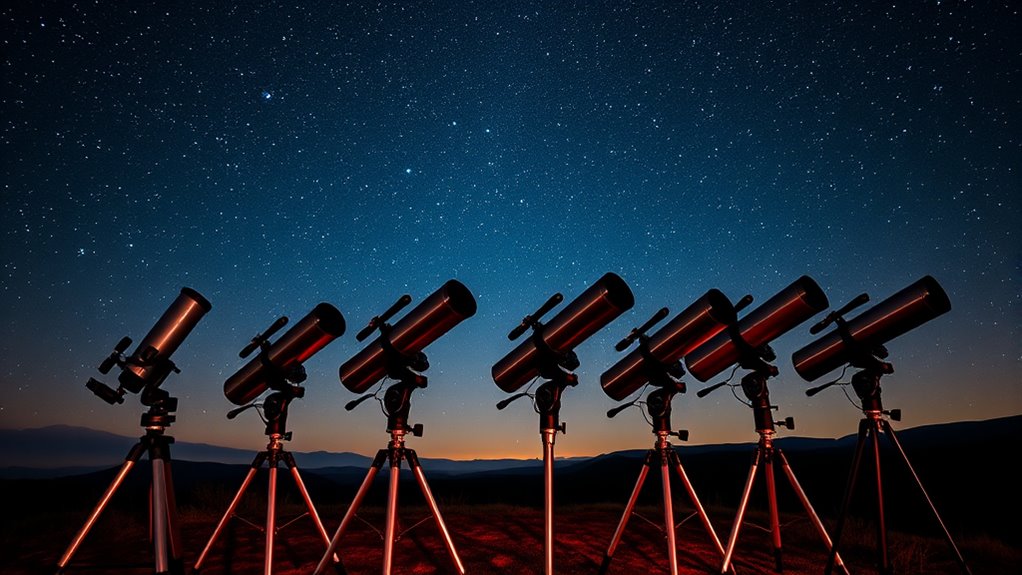If you’re looking for the best astronomy telescopes of 2025, I’ve found options like portable refractors, powerful Newtonian reflectors, and smartphone-compatible models perfect for beginners and experienced stargazers alike. Whether you want clear views of the Moon and planets or a lightweight scope for outdoor adventures, there’s something for everyone. If you keep exploring, you’ll discover detailed features and what’s ideal for your skywatching journey.
Key Takeaways
- Wide range of aperture sizes (80mm-130mm) for bright lunar and planetary views suitable for beginners and enthusiasts.
- Lightweight, portable designs with quick setup, ideal for outdoor stargazing, camping, and travel adventures.
- User-friendly features like adjustable tripods, multiple eyepieces, and smartphone adapters enhance ease of use and astrophotography.
- Stable mounts and fully coated optics deliver sharp, high-contrast images of Moon, planets, and star clusters.
- Affordable models with versatile accessories make them perfect for casual astronomy and introductory stargazing in 2025.
Telescope for Adults with Tripod and Phone Adapter
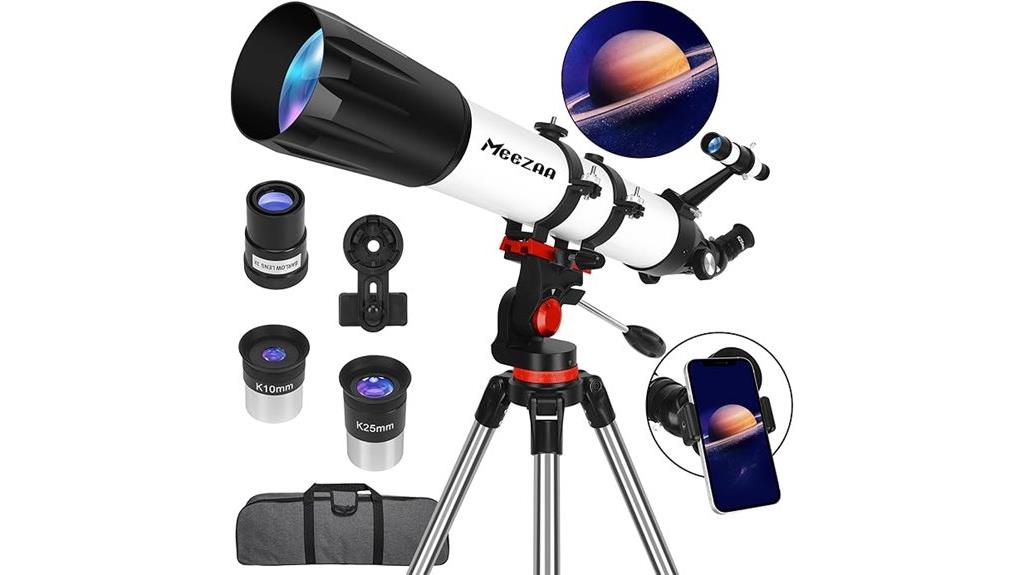
If you’re an adult or beginner looking to explore the night sky without hassle, the MEEZAA professional refractor telescope is an excellent choice. It features a 90mm aperture and 800mm focal length, delivering bright, clear images of lunar and celestial objects. The fully multi-coated lenses boost brightness and clarity, while the adjustable stainless steel tripod offers flexible viewing angles. With a phone adapter included, capturing photos and videos is simple, making sharing your discoveries easy. Setup takes around 10 minutes, thanks to clear instructions. Compact and portable, this telescope is perfect for backyard astronomy, camping, or outdoor star parties, catering to both beginners and enthusiasts.
Best For: adults and beginners seeking an easy-to-use, portable telescope for exploring the night sky, nature, and outdoor adventures.
Pros:
- Bright, clear images with a 90mm aperture and fully multi-coated lenses for enhanced clarity.
- Quick and easy setup within approximately 10 minutes, suitable for beginners.
- Comes with a phone adapter for capturing photos and videos, perfect for sharing discoveries.
Cons:
- May have limited high-magnification capabilities for advanced astronomical observations.
- Slightly bulkier tripod setup might be less convenient for very compact travel.
- Requires some manual adjustment and familiarity with basic setup procedures for optimal use.
Gskyer Telescope 600x90mm AZ Refractor Telescope for Adults

The Gskyer 600x90mm AZ Refractor Telescope is an excellent choice for beginners and casual astronomers seeking a user-friendly, high-quality telescope. Its fully coated glass optics deliver sharp, clear images while safeguarding your eyes. With three replaceable eyepieces (24X, 60X, 120X) and a 3x Barlow lens, you can easily explore celestial objects in greater detail. The adjustable aluminum tripod offers height options from about 31.5 to 49 inches for comfortable viewing. Setup requires no tools, making it quick and simple. Plus, it comes with friendly customer support and a 12-month warranty, ensuring a smooth stargazing experience.
Best For: beginners and casual astronomers looking for an easy-to-use, high-quality telescope for engaging stargazing sessions.
Pros:
- Fully coated glass optics provide sharp, clear images and eye protection.
- Multiple magnification options with three eyepieces and a 3x Barlow lens for detailed celestial viewing.
- Adjustable aluminum tripod offers customizable height for comfortable observation.
Cons:
- May not be suitable for advanced or professional astronomers needing higher magnification or specialized features.
- The telescope’s size and weight could limit portability for travel or outdoor excursions.
- Basic tripod might lack advanced stability features for extremely steady viewing during high magnification use.
Telescopes for Adults Astronomy, 80mm Aperture 600mm Refractor Telescope
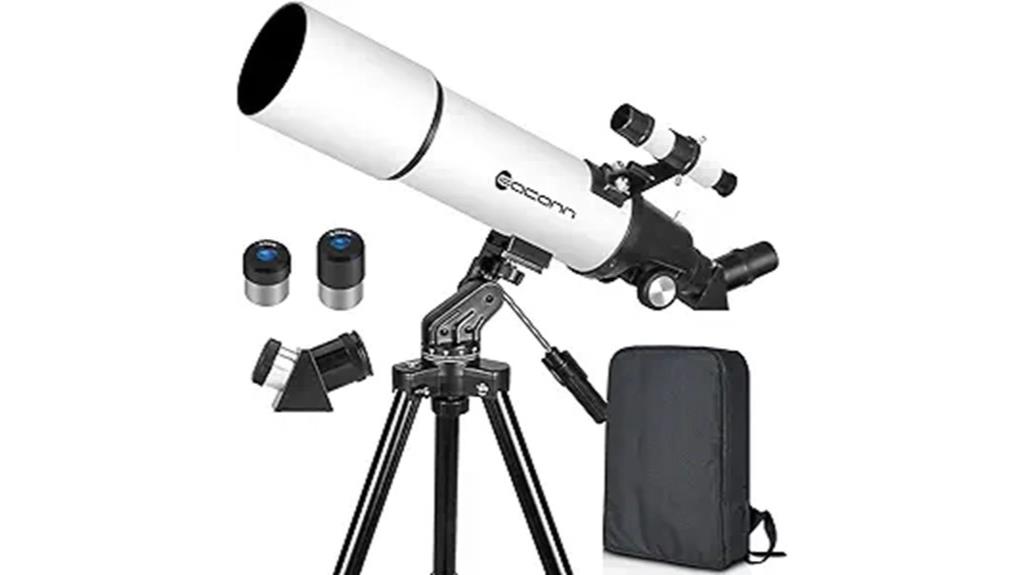
Designed for beginners and casual stargazers, the 80mm Aperture 600mm Refractor Telescope offers bright, sharp images of the moon, planets, and star clusters. Its fully coated green optics glass lens captures more light, enhancing detail and brightness. Lightweight at just 1.85 pounds, it’s easy to carry and assemble with clear instructions. The telescope features adjustable tripod, precise altitude and azimuth controls, and two eyepieces (30x-66x magnification). It also includes a phone adapter for astrophotography, making it versatile. Many users praise its ease of use, sturdy build, and impressive views, making it a great choice for beginners and family fun.
Best For: beginners, casual stargazers, and families looking for an easy-to-use, portable telescope for exploring the moon, planets, and star clusters.
Pros:
- Bright, clear images with high-quality fully coated optics glass lens
- Lightweight and portable design with easy assembly and clear instructions
- Versatile with adjustable tripod, precise controls, and a phone adapter for astrophotography
Cons:
- Limited capability for viewing deep space galaxies and faint objects
- Tripod may be slightly unstable or fiddly for some users
- Not suitable for advanced or professional astronomical observations
Telescope for Adults High Powered, 80mm Aperture 600mm Telescopes

For adult astronomy enthusiasts seeking a high-powered, portable telescope, this 80mm aperture 600mm focal length model offers an excellent balance of performance and ease of use. It features multi-coated lenses that improve light transmission, resulting in brighter, clearer images of the moon and planets. With two interchangeable eyepieces—30X and 66X magnification—it suits various observing needs. The included moon filter enhances contrast for lunar viewing. Its lightweight design, adjustable tripod, and backpack make it ideal for travel. Plus, the phone adapter lets you capture stunning celestial photos. Overall, it’s a versatile, beginner-friendly telescope perfect for exploring the night sky.
Best For: adult astronomy enthusiasts and beginners seeking a portable, easy-to-use telescope for lunar and planetary observation.
Pros:
- Bright, clear images thanks to 80mm aperture and multi-coated lenses
- Lightweight design with adjustable tripod and backpack for easy transport
- Includes two high-quality eyepieces, moon filter, and phone adapter for versatile viewing and photography
Cons:
- Limited to 66X magnification with the highest eyepiece, which may not suit deep-sky observations
- Requires some initial setup, which might be challenging for absolute beginners without assistance
- Not suitable for very detailed astrophotography due to its basic camera attachment capabilities
Telescope 130EQ Newtonian Reflector Telescopes for Adults

If you’re an adult passionate to explore the night sky with a reliable and high-performing telescope, the 130EQ Newtonian Reflector offers an excellent combination of power and ease of use. Its large 130mm aperture collects ample light, delivering bright, detailed images of planets, moons, and deep space objects. The fully-coated glass optics ensure clarity, while the sturdy German equatorial mount enables precise tracking. The lightweight, portable design makes setup straightforward, especially with included accessories like high-quality eyepieces, a moon filter, and a cellphone adapter for astrophotography. Overall, it’s a versatile telescope perfect for beginners eager to deepen their stargazing experience.
Best For: adult beginners and amateur astronomers seeking a reliable, high-quality telescope for deep space and planetary observation.
Pros:
- Large 130mm aperture provides bright, high-resolution images of celestial objects
- Fully-coated glass optics ensure clear and detailed views
- Sturdy German equatorial mount allows precise manual tracking
Cons:
- Assembly instructions may require careful reading and practice
- Phone adapter can be challenging to use or fit securely
- Some users report loose screws and packaging issues that need attention
Dianfan Telescope with 90mm Aperture and 800mm Focal Length
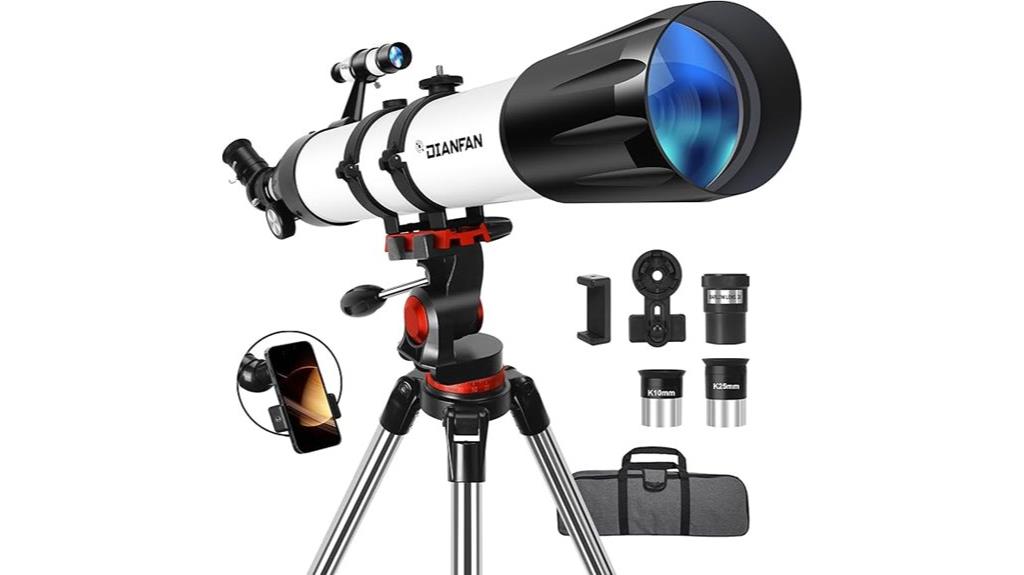
The Dianfan Telescope with its 90mm aperture and 800mm focal length stands out as an excellent choice for beginners and casual astronomers seeking a versatile, easy-to-use instrument. Its fully coated objective lens delivers bright, sharp images of the Moon, planets, and deep-sky objects. With two eyepieces, a 3× Barlow lens, and a 45° zenith mirror, it offers flexible magnification options for detailed lunar and planetary views. The lightweight design, sturdy tripod, and simple setup make it perfect for outdoor adventures or stargazing sessions near light pollution. Plus, the included phone adapter enables astrophotography, making it a well-rounded, accessible telescope for all levels.
Best For: casual astronomers, beginners, and outdoor enthusiasts looking for an easy-to-use, portable telescope with versatile viewing and astrophotography capabilities.
Pros:
- Bright, sharp images of the Moon, planets, and deep-sky objects due to fully coated 90mm objective lens
- Easy assembly and lightweight design, ideal for travel and outdoor use
- Includes multiple accessories such as eyepieces, Barlow lens, phone adapter, and sturdy tripod for enhanced viewing options
Cons:
- Limited to moderate magnifications; may not satisfy advanced astronomers seeking high-power observations
- Slightly lower portability due to size and weight compared to smaller travel telescopes
- Requires initial setup and calibration, which might be challenging for absolute beginners
ToyerBee Telescope for Adults & Kids (15X-150X, 70mm Aperture)

The ToyerBee Telescope offers a versatile and user-friendly option, making it perfect for both adults and kids enthusiastic to explore the night sky. Its 70mm aperture and adjustable 15X-150X magnification, along with high-quality coated optics, deliver bright, sharp images of the moon, planets, and stars. Lightweight at just 3.54 pounds, it’s easy to transport and set up, with clear instructions for beginners. The included smartphone adapter and wireless remote make capturing celestial moments simple. While the short tripod may need extra support for ground use, overall, this scope provides an accessible, enjoyable stargazing experience for all ages.
Best For: Beginners, kids, and families seeking an easy-to-use, portable telescope for educational and casual stargazing experiences.
Pros:
- Easy to assemble with clear instructions, suitable for children and beginners
- Bright, sharp images of the moon, planets, and stars thanks to high-quality coated optics
- Comes with a smartphone adapter and wireless remote for simple photo capturing
Cons:
- Short tripod may require additional support for stable ground use
- Some users experience assembly or build quality issues affecting durability
- Limited performance in light-polluted areas such as city environments
Telescope 150EQ Reflector Telescope for Adults
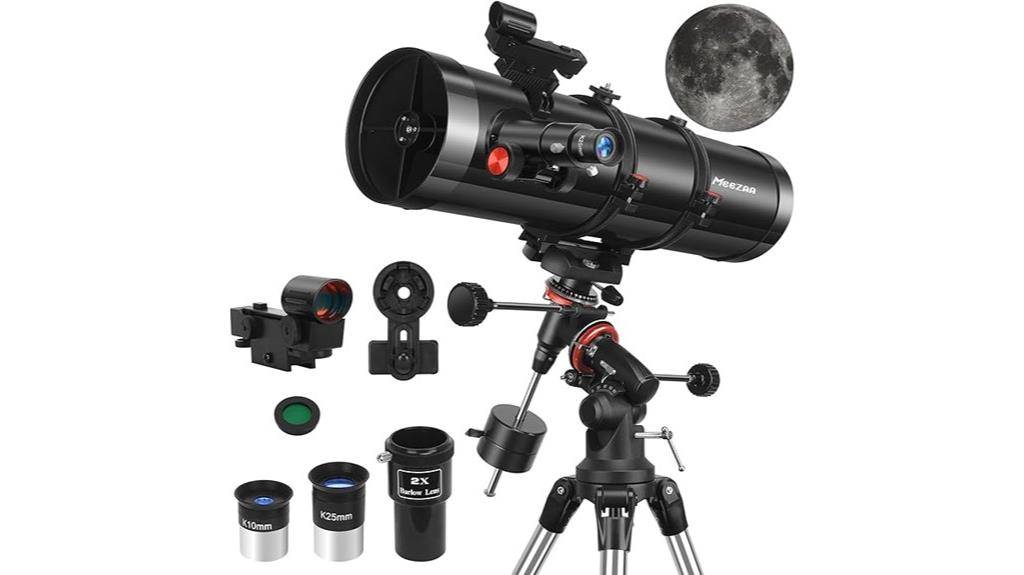
Designed for serious amateur astronomers and enthusiasts, the Telescope 150EQ Reflector offers a powerful 150mm aperture that delivers bright, detailed images of planets, galaxies, and the Moon. Its 650mm focal length provides excellent light-gathering ability, making deep-sky, planetary, and lunar observations clear and crisp. Equipped with two high-quality eyepieces, a 2X Barlow lens, and moon filter, it offers magnifications up to 130X. The upgraded German equatorial mount ensures smooth tracking and precise adjustments, while the sturdy, adjustable tripod minimizes shake. With durable construction and included accessories, this telescope is a reliable choice for both beginners and experienced stargazers.
Best For: amateur astronomers and enthusiasts seeking a versatile, durable, and feature-rich telescope for deep-sky, planetary, and lunar observation.
Pros:
- High-quality 150mm aperture and 650mm focal length deliver bright, crisp images ideal for detailed viewing.
- Includes comprehensive accessories such as eyepieces, Barlow lens, moon filter, and phone adapter for enhanced observation and astrophotography.
- Upgraded German equatorial mount provides smooth, accurate tracking with micro-adjustments for precise object targeting.
Cons:
- Mount adjustments can be less user-friendly, especially in altitude.
- Slight movement in mount lock and some plastic components may affect long-term durability.
- Limited zoom range and absence of collimation markings could challenge detailed fine-tuning.
Telescope for Adults & Kids, 70mm Aperture Refractor (15X-150X) Portable Travel Telescope
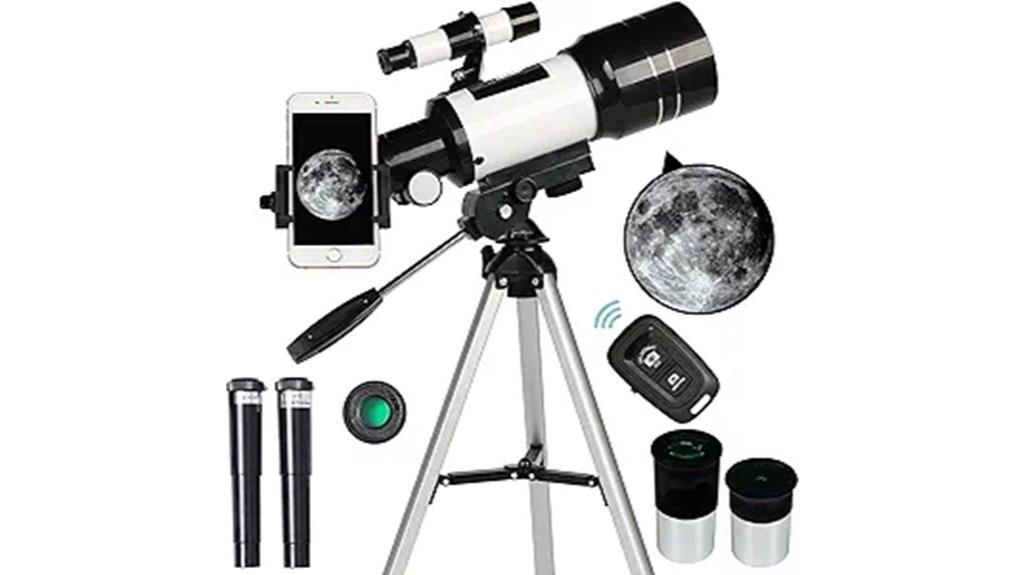
If you’re searching for a versatile, beginner-friendly telescope that suits both adults and kids, this 70mm aperture refractor stands out. Its lightweight, portable design makes it perfect for backyard stargazing, camping trips, or travel. With a magnification range from 15X to 150X, it delivers bright, clear views of the moon, planets, and stars. The set includes two eyepieces, a Barlow lens, a phone adapter, and a wireless remote, making astrophotography easy for beginners. Assembly takes less than 10 minutes, and its durability ensures years of use. While stability can be an issue, its overall value and user-friendly features make it an excellent choice for family astronomy adventures.
Best For: beginners, families, and kids interested in casual astronomy and portable stargazing experiences.
Pros:
- Easy to assemble and lightweight for portability and travel
- Includes useful accessories like phone adapter and wireless remote for astrophotography
- Bright, clear images of the moon, planets, and stars suitable for beginners
Cons:
- Tripod stability issues due to wobbling and top-heavy design
- Frustrating aiming system that makes fine adjustments difficult at higher zoom levels
- Some users report low image clarity at maximum magnification and occasional manufacturing defects
Celestron PowerSeeker 127EQ Telescope

For beginners seeking an affordable yet powerful entry-level telescope, the Celestron PowerSeeker 127EQ stands out as an excellent choice. Its 127mm Newtonian reflector collects enough light to clearly observe planets, Moon craters, stars, and even deep-sky objects like the Orion Nebula. The sturdy German Equatorial mount with slow-motion controls makes tracking objects smooth and straightforward. It comes with multiple eyepieces and a 3x Barlow lens, offering versatile magnification options. Compact and lightweight, it’s perfect for backyard, campsite, or dark-sky adventures. Plus, the included software and accessories enhance learning and ease of use for beginners and young enthusiasts alike.
Best For: beginner astronomy enthusiasts, including families and young stargazers, seeking an affordable and versatile telescope for planetary and deep-sky observation.
Pros:
- Easy to set up and use, ideal for beginners.
- Robust German Equatorial mount for smooth tracking of celestial objects.
- Includes multiple eyepieces and Barlow lens for versatile magnification options.
Cons:
- Basic finder scope may require upgrading for easier object locating.
- Tripod can feel flimsy; proper balancing is necessary for stability.
- Regular collimation and alignment are needed to maintain optimal image quality.
Celestron Travel Scope 70 Portable Refractor Telescope
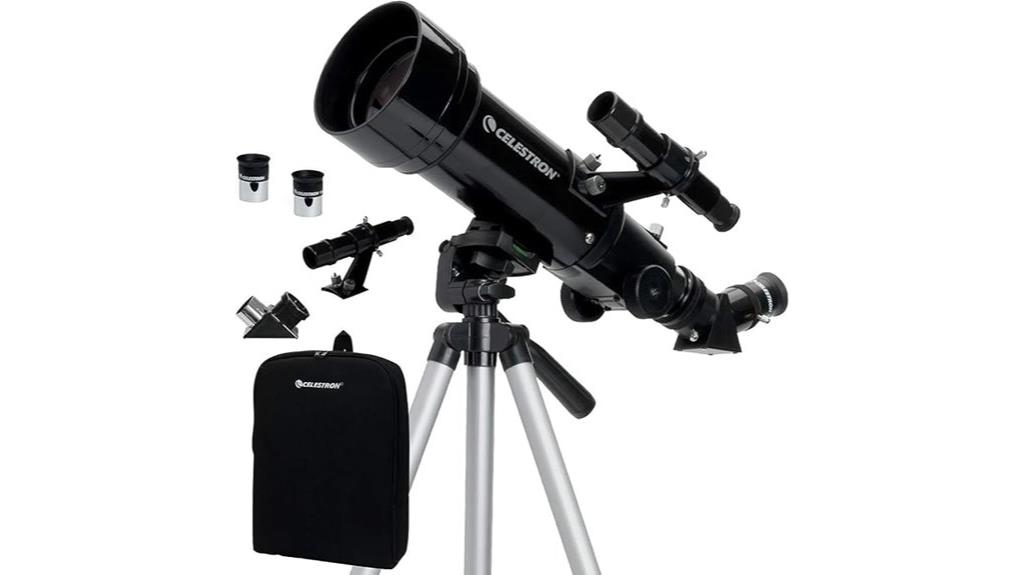
The Celestron Travel Scope 70 Portable Refractor Telescope stands out as an excellent choice for beginners, travelers, and outdoor enthusiasts seeking an easy-to-use, lightweight instrument. Weighing just 4.2 pounds and measuring 18 x 7 x 14 inches, it’s perfect for quick setup and portability. Its 70mm aperture and coated glass optics deliver bright, crisp images of the Moon, planets, and terrestrial scenes. The package includes two eyepieces, a star diagonal, a full-height tripod, and a custom backpack, making it easy to transport and store. While it’s ideal for casual stargazing and daytime viewing, upgrading the tripod can improve stability for more detailed planetary observations.
Best For: beginners, travelers, and outdoor enthusiasts seeking an easy-to-use, portable telescope for casual astronomy and terrestrial viewing.
Pros:
- Lightweight and highly portable at just 4.2 pounds, ideal for travel and outdoor use
- Easy to set up without tools, making it perfect for quick observations
- Includes essential accessories like eyepieces, star diagonal, and backpack for convenience
Cons:
- Small tripod can cause wobble, affecting stability during detailed observations
- Limited to basic planetary and lunar views without advanced upgrades
- May require tripod upgrades or additional accessories for optimal stability and astrophotography
Celestron AstroMaster 70AZ Refractor Telescope

Ideal for beginners, the Celestron AstroMaster 70AZ Refractor Telescope offers bright, clear views of the Moon, planets, and star clusters. Its 70mm fully coated achromatic optics deliver crisp images, perfect for learning the night sky. The alt-azimuth mount with a smooth panhandle makes navigation straightforward, while the quick, tool-free setup saves time. The sturdy tripod adjusts for comfortable viewing, whether standing or seated. It includes two eyepieces, a star diagonal, and a red dot finderscope, plus free software to boost your exploration. Backed by a 2-year warranty and US-based support, this telescope is a reliable, user-friendly choice for budding astronomers.
Best For: beginners of all ages seeking an easy-to-use, versatile telescope for both astronomical and terrestrial viewing.
Pros:
- Easy quick-setup with no tools required, ideal for beginners.
- Bright, detailed images of the Moon, planets, and star clusters thanks to 70mm fully coated achromatic optics.
- Includes essential accessories like two eyepieces, star diagonal, and red dot finderscope, plus free educational software.
Cons:
- Limited to beginner-level observations; may not satisfy advanced astronomers.
- Alt-azimuth mount provides simple navigation but lacks advanced tracking features.
- Optical performance may be affected by atmospheric conditions or light pollution in certain areas.
Celestron StarSense Explorer LT 114AZ Telescope with Smartphone Dock

If you’re just starting out in astronomy and want an easy-to-use telescope that guides you every step of the way, the Celestron StarSense Explorer LT 114AZ is a standout choice. It features a 114mm Newtonian reflector with high-quality coatings, offering bright views of the Moon, planets, and deep-sky objects like the Orion Nebula and Andromeda Galaxy. Its app-enabled StarSense technology uses sky recognition and navigation to help locate objects effortlessly. The telescope is lightweight, portable, and easy to set up, making it perfect for beginners. With included eyepieces, a red dot finder, and smartphone dock, it’s an accessible and engaging way to explore the night sky.
Best For: beginners and amateur astronomers seeking an easy-to-use, app-guided telescope for casual stargazing and planetary observation.
Pros:
- User-friendly setup with quick initial assembly and no collimation required
- App-assisted object locating with real-time guidance and sky recognition technology
- Lightweight, portable design suitable for travel and outdoor use
Cons:
- Slight wobble in the tripod and mount can affect image stability during observation
- Potential calibration issues or app recognition problems may require troubleshooting
- Limited deep-sky capability, primarily suited for lunar and planetary viewing
Telescope with 90mm Aperture and 900mm Focal Length

A 90mm aperture combined with a 900mm focal length makes this telescope a standout choice for beginners and outdoor enthusiasts keen to explore the night sky without lugging around heavy equipment. Its large, multi-coated lens delivers brighter, clearer images of the Moon, planets, and distant landscapes. The AZ mount offers smooth 360° rotation and adjustable height, making tracking objects easy and stable. With quick assembly, a smartphone adapter, and a portable carry bag, it’s perfect for backyard stargazing, camping, or outdoor adventures. The complete kit includes eyepieces, a finder scope, and accessories, providing everything I need to start exploring right away.
Best For: beginners and outdoor enthusiasts looking for a portable, easy-to-use telescope for celestial and landscape viewing.
Pros:
- Large 90mm aperture with multi-coated lens for brighter, clearer images
- Stable AZ mount with 360° rotation and adjustable height for precise tracking
- Comes with a complete kit including eyepieces, smartphone adapter, and carry bag for immediate use
Cons:
- Magnification range (36X to 270X) may be limited for advanced astronomical observations
- Quick assembly may still require some familiarity with telescope components for optimal setup
- Slightly heavy for ultra-portable use, depending on individual portability needs
Telescope for Adults & Kids with AZ Mount and Accessories

The HUGERSTAR telescope stands out as a versatile choice for both adults and kids, thanks to its user-friendly AZ mount and all-inclusive accessories. Its 80mm aperture and 600mm focal length deliver bright, detailed views of the Moon, planets, and some deep-sky objects. The fully multi-coated optics guarantee high contrast and minimal glare. With eyepieces, a Barlow lens, moon filter, phone adapter, and sturdy tripod, it offers excellent value and easy setup in under 10 minutes. Its lightweight, portable design makes it great for backyard astronomy, camping, or wildlife observation. Perfect for beginners, it combines simplicity with powerful features to spark curiosity and exploration.
Best For: beginners, families, and outdoor enthusiasts looking for an easy-to-use, portable telescope for lunar, planetary, and daytime nature viewing.
Pros:
- User-friendly AZ mount and quick setup, ideal for novices and kids
- Bright, high-contrast images with fully multi-coated optics
- Portable and lightweight design perfect for outdoor adventures and travel
Cons:
- Lacks motorized tracking for continuous object observation
- Focal length primarily suited for lunar and planetary views, limiting deep-sky exploration
- Tripod may be less stable at higher magnifications, affecting image steadiness
Factors to Consider When Choosing Astronomy Telescopes

When selecting an astronomy telescope, I focus on key factors that impact my viewing experience. Things like optical quality, magnification options, and mount stability are essential, along with how portable and easy it is to set up. Knowing these details helps me pick a telescope that fits my needs and makes stargazing more enjoyable.
Optical Quality and Clarity
Optical quality plays a crucial role in how clearly you can see celestial objects through a telescope. The clarity depends on the size and coating of the lenses or mirrors, which influence image brightness, contrast, and sharpness. Fully coated or multi-coated optics minimize reflections and light loss, resulting in more detailed and vibrant images. A larger aperture gathers more light, making faint objects visible and improving overall clarity. The optical design also matters; refractors typically deliver crisp, high-contrast views with less maintenance, while reflectors can offer larger apertures at a lower cost. High-quality optics reduce distortions like chromatic aberration and coma, ensuring accurate color and sharpness across the field of view. Prioritizing these factors helps you choose a telescope that delivers the clearest, most detailed astronomical views.
Magnification Range Options
Choosing the right magnification range is essential because it directly impacts how you observe celestial objects. A versatile telescope should offer options from about 30X to over 200X, allowing you to view wide star fields or detailed planetary features. Common magnifications include low-power views around 30X to 50X, ideal for large star clusters and nebulae, and high-power views exceeding 200X for lunar details or planetary surfaces. Remember, maximum usable magnification is usually about 50X per inch of aperture; for example, a 70mm telescope can reach roughly 140X. However, higher magnifications can cause dimmer, less stable images, especially if atmospheric conditions or mount stability aren’t ideal. Balancing magnification range with your observing goals ensures a more enjoyable stargazing experience.
Mount and Stability
A stable mount is essential for getting clear, sharp images during your stargazing sessions because even small vibrations can blur details, especially at higher magnifications. The material of the tripod plays a big role; metal tripods tend to be more rigid and stable than plastic ones. Adjustable mounts are beneficial because they let you fine-tune your viewing angle and track celestial objects smoothly across the sky. Equatorial mounts are especially useful for tracking, as they follow Earth’s rotation, reducing the need for constant repositioning during long viewing sessions. Tripod height and balance are critical—an improperly adjusted or unstable tripod can cause wobbling, making precise observations difficult. Overall, investing in a sturdy, well-balanced mount ensures a better, frustration-free stargazing experience.
Portability and Size
When selecting an astronomy telescope, considering its portability and size can make a big difference in your stargazing experience. Portable telescopes usually weigh between 4 to 20 pounds, making them easy to carry for outdoor adventures. Compact models with foldable or collapsible designs fit into small bags or cases, perfect for travel or quick setup. Adjustable tripods and collapsible mounts help you find comfortable viewing angles, regardless of your environment. Lightweight telescopes are especially suitable for children and beginners, reducing fatigue during long sessions. However, larger, more powerful telescopes tend to be bulkier and less portable, often requiring additional carrying gear or vehicle transport. Balancing size and portability is key to making the most of your stargazing adventures.
Ease of Assembly
Ease of assembly is a crucial factor because it directly affects how quickly you can start observing the night sky. A telescope that’s simple to set up typically features tool-free assembly and clear instructions, allowing most users to complete it within 10 to 15 minutes. Telescopes with straightforward mounting systems, like alt-azimuth or basic tripods, cut down on complex adjustments and tools. Lightweight, modular parts make assembly quick and disassembly easy, boosting portability and user-friendliness, especially for beginners. Pre-aligned optics and intuitive controls help minimize calibration time, ensuring a smooth start. Additionally, user manuals with step-by-step guidance and helpful videos can considerably speed up setup, making your transition from unboxing to stargazing seamless and enjoyable.
Accessories and Compatibility
Choosing a telescope that’s compatible with a wide range of accessories can substantially enhance your observing experience. I look for models that support standard accessories like smartphone adapters, eyepieces, and filters, which allow me to expand my observational capabilities easily. It’s also vital that the mounting system accommodates accessories such as camera mounts, finderscopes, or additional lenses, offering versatility for different activities. I pay attention to eyepiece sizes, preferring those with common diameters like 1.25 inches for straightforward upgrades. Compatibility with optional accessories like solar filters or astrophotography adapters is a plus, as it broadens my viewing options. Finally, I consider the mounting type, ensuring it supports accessory attachments for precise tracking and long-exposure imaging, essential for serious astrophotography.
Budget and Value
Selecting a telescope that offers the best value for your budget requires careful comparison of features and quality. I recommend setting a clear budget range first and then evaluating telescopes within that limit to find the best combination of performance and cost. Look closely at optical performance, such as aperture size and coatings, since these affect image brightness and clarity. Don’t forget to contemplate included accessories like eyepieces, mounts, and cases—they add value and convenience. Higher-priced models often deliver better durability, stability, and advanced features, which can save you money long-term. Balancing initial cost with long-term usability and upgrade potential ensures your investment remains worthwhile. Ultimately, choosing a telescope that maximizes quality within your budget provides the best overall value for your stargazing adventures.
Intended Observation Types
When picking a telescope, understanding your primary observation goals is essential because different types of astronomy require specific optical features and accessories. If you’re into planetary or lunar viewing, you’ll want a telescope with higher magnification capabilities, supported by quality eyepieces and Barlow lenses, often reaching 240X or more. For deep-sky objects like galaxies, nebulae, and star clusters, a larger aperture (at least 80mm) and a stable mount are vital for long exposure astrophotography. Terrestrial and daytime viewing are best suited for refractor telescopes with upright images, often equipped with zenith mirrors or star diagonals. Ultimately, your choice depends on whether you aim to observe planets, deep-sky objects, or terrestrial scenes, guiding your selection of features like focal length and mount type.
Frequently Asked Questions
How Do I Choose the Best Telescope for Beginner Stargazing?
To choose the best telescope for beginner stargazing, I recommend starting with a user-friendly and versatile model like a Dobsonian or a beginner-friendly refractor. Look for one with easy setup, good magnification, and solid optics. Consider your budget and what you want to observe most—planets, stars, or deep-sky objects. Reading reviews and asking experienced stargazers can also help you make a confident choice.
What Features Differentiate High-Powered Telescopes From Basic Models?
High-powered telescopes differ mainly in their aperture size, which determines how much light they can gather, giving you clearer, more detailed images of distant objects. They also often feature advanced mounts for stability, higher magnification capabilities, and better lenses or mirrors. These features make high-powered telescopes ideal for serious stargazing, but they can be more complex and expensive compared to basic models, which are great for beginners.
Are Portable Telescopes Suitable for Astrophotography?
They say, “the right tool makes all the difference,” and portable telescopes can indeed be suitable for astrophotography. I’ve found that lightweight models with stable mounts and good optics perform surprisingly well, especially for beginners. While they might not match the capabilities of larger, dedicated setups, they’re perfect for capturing wide-field shots and practicing your skills under the night sky. Just remember, patience and practice are key!
How Important Is the Type of Mount for Astronomical Observations?
The type of mount is extremely important for astronomical observations because it directly affects stability and ease of tracking celestial objects. I find that equatorial mounts are ideal for long-exposure astrophotography, as they follow the stars’ movement precisely. Altazimuth mounts are simpler and better for quick views, but they lack the accuracy needed for detailed observations. Choosing the right mount depends on your specific stargazing goals.
What Maintenance Is Required to Keep a Telescope in Optimal Condition?
To keep my telescope in top shape, I regularly clean the lenses with a soft brush and lens cloth, avoiding harsh chemicals. I also check and tighten screws and mountings to guarantee stability. It’s important to cover the telescope when not in use to protect it from dust and moisture. Additionally, I store it in a dry, cool place and occasionally calibrate the optics for sharp images.
Conclusion
Choosing the right telescope is like finding a key to unveil the universe’s secrets. With so many options in 2025, you’ll find the perfect match to fuel your stargazing adventures. Remember, the right telescope can turn a night sky into a canvas of wonders. So, pick wisely, and let your curiosity soar beyond the stars—your celestial journey is just a telescope away. Happy stargazing!
